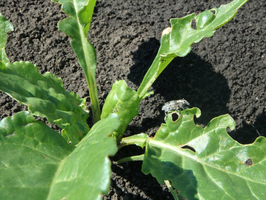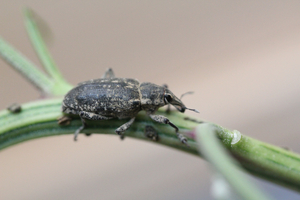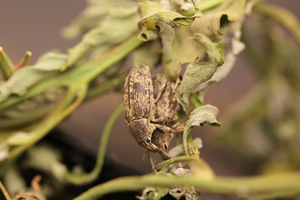Beet root weevil
Asproparthenis punctiventris
Biology
The beet root weevil Asproparthenis punctiventris(synonym: Bothynoderes punctiventris) belongs to the weevil family(Curculionidae).
In spring, as soon as the soil temperature rises above 8 °C at a depth of 10 cm and the surface of the soil is dry, the beetles leave their winter habitat. The onset of ripening feeding occurs when the air temperature reaches a minimum of 15 °C. The feeding on suitable food plants, which begins after migration, is to be regarded as maturation feeding, since the female beetles still have completely underdeveloped ovaries after overwintering in the soil. The beet root weevil feeds mainly on turnip plants, on the roots of which its larvae can also be found in June and July. However, these rarely cause noticeable damage to the beet and pupate at the feeding site in July. In the same year, the pupae develop into the finished young beetles. However, these remain in the pupal nest until the following spring.
Damage symptoms
From April to early June, the beet root weevil appears on the seedlings and young plants. The pest causes marginal or pitting damage to the leaves of young beet plantlets. In the cotyledon stage of sugar beet, the beet root weevil can cause bare root feeding at densities as low as one beetle per square meter.
Host plants
The host plants of the beet root weevil mainly include various species from the foxtail family(Amaranthaceae). In addition to sugar beet(Beta vulgaris subsp. vulgaris, Altissima group), the menu of the voracious pest also includes chard(Beta vulgaris subsp. vulgaris, Cicla group and Flavescens group), spinach (Spinaciaoleracea), red beet (Beta vulgaris subsp. Vulgaris, Conditiva group) and white goosefoot(Chenopodium album).
Propagation and transmission
In the spring, with precipitation-free weather and long periods of sunshine, the beet root weevils begin to migrate from the previous year's beet fields. Since the beetles' migration is interrupted during cold snaps and precipitation events, the beetles usually migrate to the new beet fields in waves. beet root weevils are capable of flight from temperatures of 22°C upward, but beetle migration plays a greater role than flight in their dispersal.
Economic importance
In Austria's sugarbeet-growing regions, the beet root weevil is one of the most economically significant pests. The risk of total damage is particularly high in the plains of northeastern Austria. Since the mortality of beet root weevil eggs and larvae increases at low temperatures and high soil moisture, low precipitation and high average temperatures in the months of April to June favor the development of the beet root weevil.
Prevention and control
- Crop rotation, early sowing and promotion of youth development; do not plant beets directly next to previous year's beet or alfalfa fields
- Draw trap grooves in stands after sugar beet (= old plots) as well as in this year's sugar beet plots
- Equip old plots with pheromone traps to reduce the number of escaping beetles. In case of very strong occurrence, the distance between the pheromone traps should be reduced to up to 10 m.
- Seeding this year's sugar beet areas with pheromone traps after the beetle has emigrated from the old areas.
- Use of insecticides: Combination of dressed seed with multiple spray applications, each at approved intervals and approved application rates. The time of treatment depends on the activity of the beetle and the weather; in case of high temperatures treat towards evening or in the morning
Services
Last updated: 09.10.2025
automatically translated


